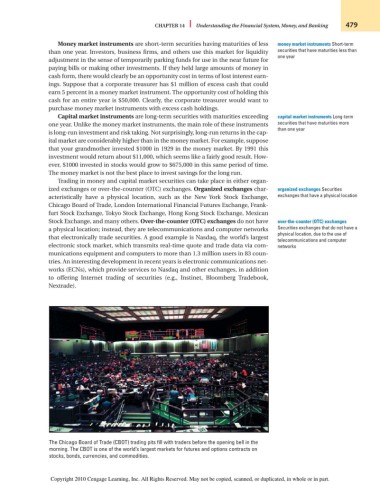Page 505 - Introduction to Business
P. 505
CHAPTER 14 Understanding the Financial System, Money, and Banking 479
Money market instruments are short-term securities having maturities of less money market instruments Short-term
than one year. Investors, business firms, and others use this market for liquidity securities that have maturities less than
one year
adjustment in the sense of temporarily parking funds for use in the near future for
paying bills or making other investments. If they held large amounts of money in
cash form, there would clearly be an opportunity cost in terms of lost interest earn-
ings. Suppose that a corporate treasurer has $1 million of excess cash that could
earn 5 percent in a money market instrument. The opportunity cost of holding this
cash for an entire year is $50,000. Clearly, the corporate treasurer would want to
purchase money market instruments with excess cash holdings.
Capital market instruments are long-term securities with maturities exceeding capital market instruments Long-term
one year. Unlike the money market instruments, the main role of these instruments securities that have maturities more
than one year
is long-run investment and risk taking. Not surprisingly, long-run returns in the cap-
ital market are considerably higher than in the money market. For example, suppose
that your grandmother invested $1000 in 1929 in the money market. By 1991 this
investment would return about $11,000, which seems like a fairly good result. How-
ever, $1000 invested in stocks would grow to $675,000 in this same period of time.
The money market is not the best place to invest savings for the long run.
Trading in money and capital market securities can take place in either organ-
ized exchanges or over-the-counter (OTC) exchanges. Organized exchanges char- organized exchanges Securities
acteristically have a physical location, such as the New York Stock Exchange, exchanges that have a physical location
Chicago Board of Trade, London International Financial Futures Exchange, Frank-
furt Stock Exchange, Tokyo Stock Exchange, Hong Kong Stock Exchange, Mexican
Stock Exchange, and many others. Over-the-counter (OTC) exchanges do not have over-the-counter (OTC) exchanges
a physical location; instead, they are telecommunications and computer networks Securities exchanges that do not have a
physical location, due to the use of
that electronically trade securities. A good example is Nasdaq, the world’s largest
telecommunications and computer
electronic stock market, which transmits real-time quote and trade data via com- networks
munications equipment and computers to more than 1.3 million users in 83 coun-
tries. An interesting development in recent years is electronic communications net-
works (ECNs), which provide services to Nasdaq and other exchanges, in addition
to offering Internet trading of securities (e.g., Instinet, Bloomberg Tradebook,
Nextrade).
The Chicago Board of Trade (CBOT) trading pits fill with traders before the opening bell in the
morning. The CBOT is one of the world’s largest markets for futures and options contracts on
stocks, bonds, currencies, and commodities.
Copyright 2010 Cengage Learning, Inc. All Rights Reserved. May not be copied, scanned, or duplicated, in whole or in part.

